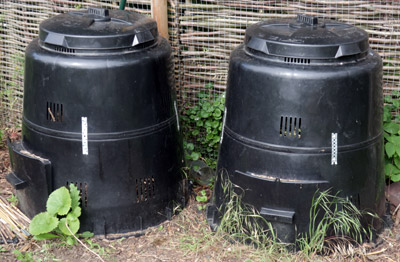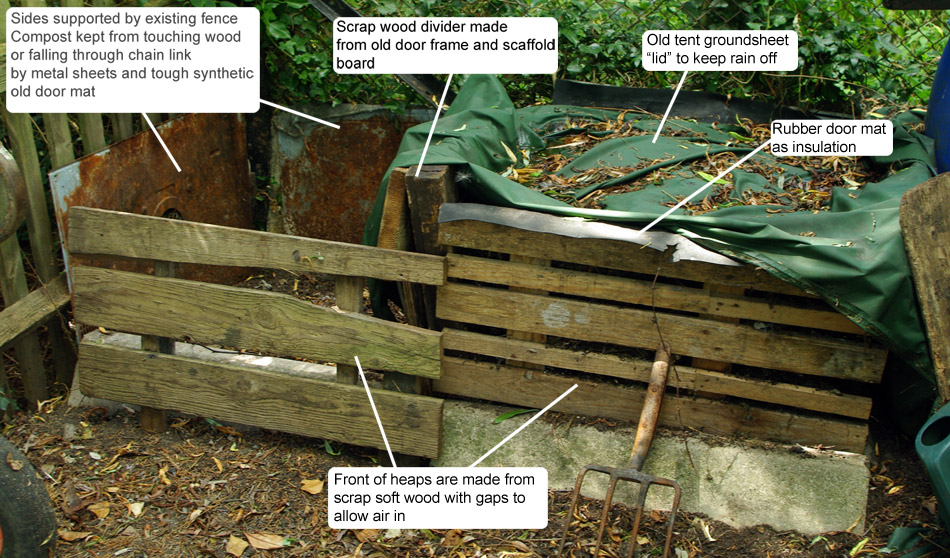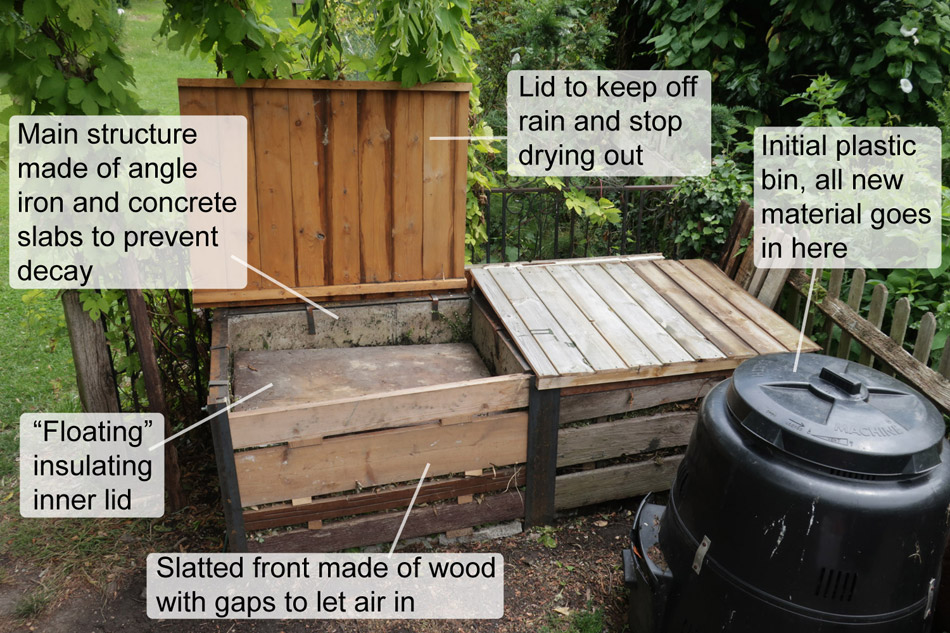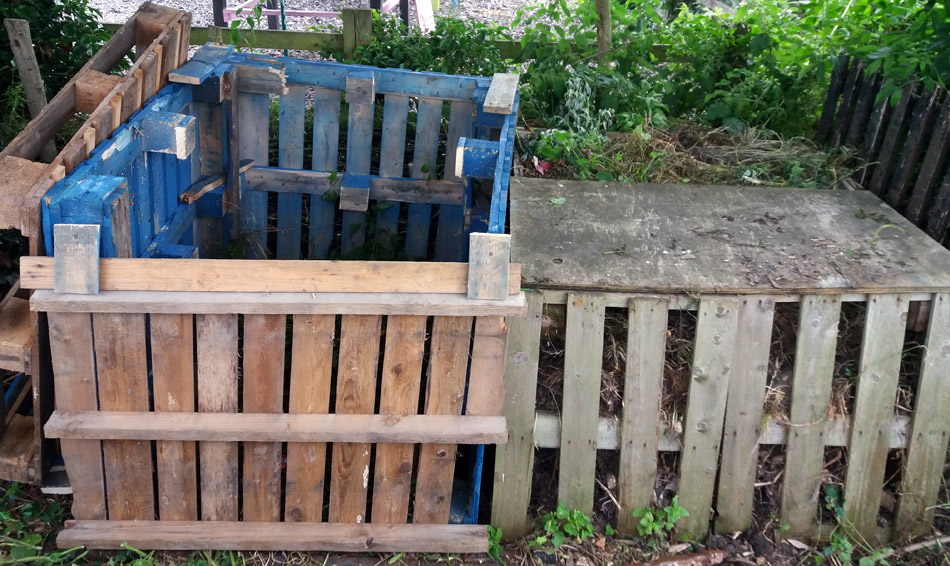What kind of bin or heap should
you get?
How many should you get?
Compost Heaps and Bins for Your Garden
You'll need a container to make your garden compost. Should you buy one or make one? How big, what materials and what design?

Other composting pages: Compost maker bins | Basic Composting | Q and A's
You can buy your composting "solution" straight off the shelf, buy materials to make one yourself or build one from whatever scrap you have around. I've been making compost for over 30 years and until this year I'd never spent a penny on doing so.
Compost heaps are all about recycling so it's always made sense to me to make one out of recycled materials where possible. Because compost heaps can be hidden out of the way somewhat, you don't need to make them look very pretty, functional will do.

These were my old compost heaps
that I used for over 20 years though in reality they were like
Triggers' broom, "Maintained it for 20 years. This
old brooms had 17 new heads and 14 new handles in its time."
The principles are simple enough, use materials for the sides
that will not rot along with the compost, have an insulating
lid and a waterproof lid and have gaps along at least one side
to let air in.
Materials:
 Plastic
ready-made bins - I'm usually a fan of natural
materials wherever possible in the garden but lightweight purpose
made plastic compost bins are a great way to start composting
and will last for many, many years if not abused
more here. If you find you
need bigger heaps later on, the plastic bin will still be very
useful. All and any fresh material in my garden goes into one
of these first where it undergoes the first stage of composting
whereby the volume reduces enormously, when it's eventually
full and won't go down any more I turn the contents upside
down on one of the longer term compost heaps.
Plastic
ready-made bins - I'm usually a fan of natural
materials wherever possible in the garden but lightweight purpose
made plastic compost bins are a great way to start composting
and will last for many, many years if not abused
more here. If you find you
need bigger heaps later on, the plastic bin will still be very
useful. All and any fresh material in my garden goes into one
of these first where it undergoes the first stage of composting
whereby the volume reduces enormously, when it's eventually
full and won't go down any more I turn the contents upside
down on one of the longer term compost heaps.
Wood - A compost heap is somewhere to put plant material to rot down, if any part of the heap is made of wood (plant material) that is in direct contact with the contents, it will rot in time too. It may be a long time before it does so (several years at least) but it will get weakened first and break before it disappears. This is not necessarily a major issue and parts of my compost heaps have been made of wood for many years, scrap wood that would otherwise have been thrown as not being good enough for any other purpose. If you use wood for your compost heap be aware of this and that you will have to replace those parts in the future.
Pressure treated timber - the best widely available choice, solid softwood that is impregnated with a preservative at a reasonable price, it will make the wood last much longer than if not treated but will still rot in time, especially if any part of it is in the ground.
Softwood - If you're going to buy wood for your compost heap, get pressure treated softwood, the small extra cost will be much better value. Scrap softwood however lends itself well to making a compost heap rather than throwing it away.
Hardwood - I'm not suggesting you go and spend a fortune on buying hardwood to make a compost heap, but it may be available from old broken or discarded furniture, it will probably last longer than pressure treated softwood.
Plywood - There are two grades of plywood, exterior and interior, only use exterior grade outdoors, the interior grade will start to delaminate within a year or so and the wood itself is less resilient. In any case plywood is not good for the walls of the heap in contact with the contents and won't last as long as solid timber, but is good for lids.
MDF, OSB, fiberboard, chipboard etc. - Composite boards made from wood chips glued together are useless here. They will soak through with rain which causes them to swell and start to disintegrate quite quickly, I have used them rarely in the past (this is how I found they were so useless) if nothing else was available, but they will need replacing within a year and are best avoided altogether as they can be messy as they disintegrate.
Pallets - These make good raw materials to make a compost heap from, scroll further down the page for more.
Synthetic boards - These are an excellent choice for the walls that are in direct contact with the rotting compost as they won't decay and should last for many years ( a couple of decades or more). Plastic is degraded by sunlight and their use in a compost heap usually shields them from this. Generally they are not strong enough to stand up on their own but can be held up by a wooden frame, wire fencing or similar. One of the best materials I've used has been an old estate agents sign which are made of twin wall polypropylene. if you haven't moved recently you can buy it as correx sheets here. Polycarbonate sheets could also be used but are more brittle and more expensive.
Synthetic door mats - An unlikely sounding thing to use, but I have used an old sturdy synthetic fibre doormat for many years held in place against chain link fencing as one wall of a compost heap to great effect.
Metal sheets - Again, not something to buy but a useful way to recycle if you have something suitable. I have used steel sheets that came from an old dismantled washing machine.

These are my new compost heaps,
each is about 60 x 60 x 90 cm, they have a frame-work of angle
iron (50 x 50 x 3 mm bought onlline for about £65 inc. delivery
in June 2021) held together by some 10mm bolts I had. The walls
and base are made of 60 x 60 cm heavy concrete slabs that I
got for free from the village FaceBook page. The angle-iron
legs extend about 15cm into the ground and are concreted in.
I was rearranging the bottom of the garden and it seemed time
to make heaps that weren't constantly disintegrating and
had to be re-built. Only the front is wood and due to the gaps
drying the area around them, this part rots the most slowly.
I have used slabs for the base as well to make emptying them
easier as when placed on the ground, you eventually end up digging
some soil out too. I thought these would stop worms getting in but these heaps have more worms than ever before which help speed up the rotting process. The lids were made from an old
shed I dismantled
Pallets
Wooden pallets can be good for making a compost heap from, especially as they are somewhat ready-made. If you intend to do this, I suggest you get 4 pallets of the same size (it's surprising how much they vary) and use them whole. You can dismantle pallets to use the wood but it is much harder work in reality than it seems in prospect and you will probably break a good few of the planks in the process. Stand three pallets on the ground and screw or nail them together, the fourth side should be left loose to allow the compost to eventually be removed at a later date. Some kind of temporary fixing should be used to keep the last pallet in place that can be reversed easily. You'll need to make a lid out of something else, I suggest a lid of two halves so it's not too heavy.
The disadvantages of using pallets is that they are generally very large being around a metre square which is good if you have a very large garden but not so much if it is more normal sized. There are also rather more gaps than is ideal which can lead to the compost drying out, this is where the two half lids can help, just use one in the summer months moving it occasionally to let the rain water the heap and them put them both on in the winter so it doesn't get too wet.

Two pallet compost heaps, the one
on the right is full, hence making a new one on the left which
is a bit wonky because there's a big tree root on the ground.
I removed some of the internal planks to eventually make getting
the compost out somewhat easier.
Copyright 2000 - present. All Rights Reserved | Privacy Policy Statement
